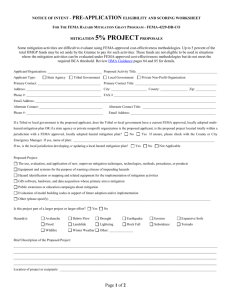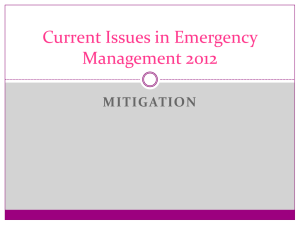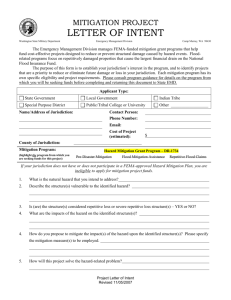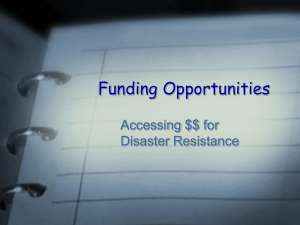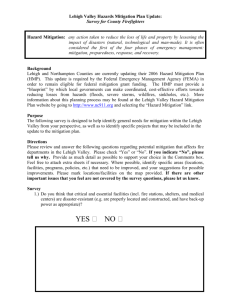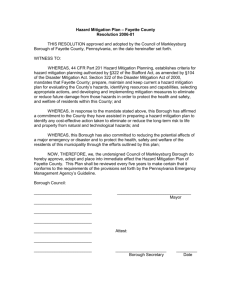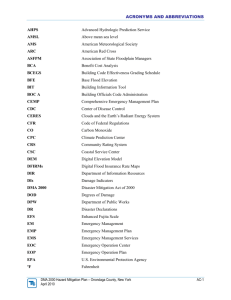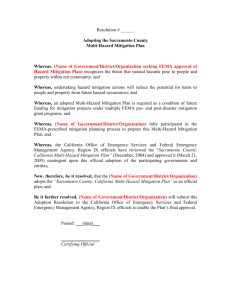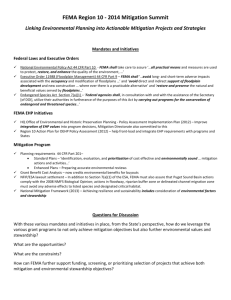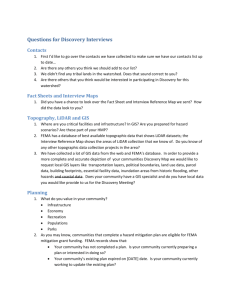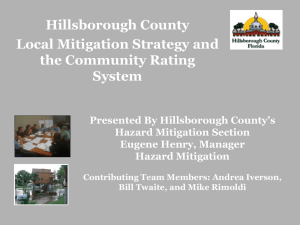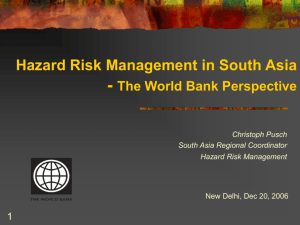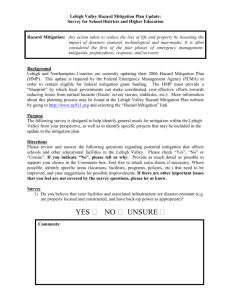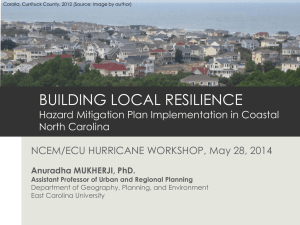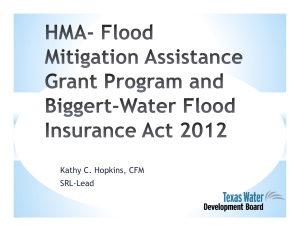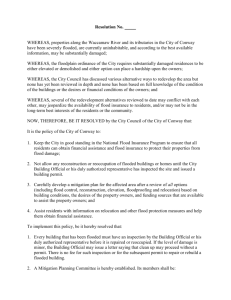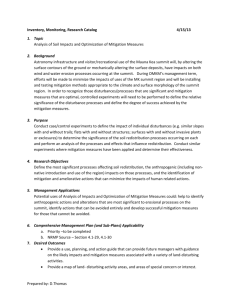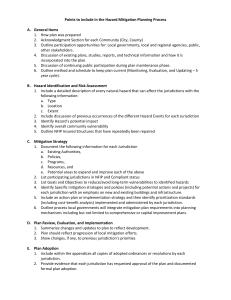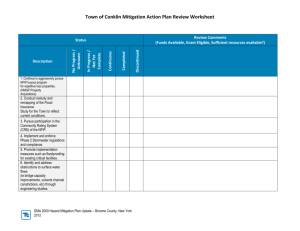Pre-Disaster Mitigation Plan Update Powerpoint Presentation
advertisement
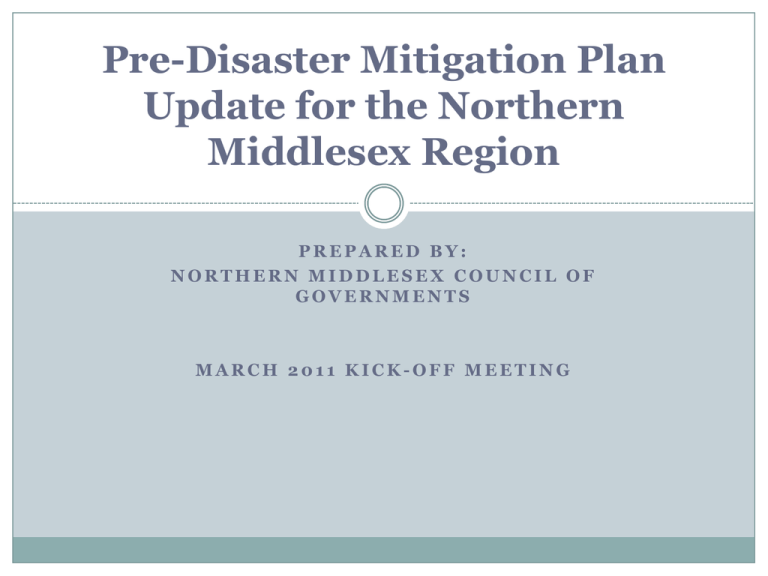
Pre-Disaster Mitigation Plan Update for the Northern Middlesex Region PREPARED BY: NORTHERN MIDDLESEX COUNCIL OF GOVERNMENTS MARCH 2011 KICK-OFF MEETING Why Prepare an Updated Plan? The Disaster Mitigation Act of 2000: all states, regions and localities must prepare a hazard mitigation plan to be eligible for future FEMA funding under the PreDisaster Mitigation (PDM), Flood Mitigation Assistance Program (FMA) and Hazard Mitigation Grant Program (HMGP) o o Emphasis on strong, integrated state and local planning Sanctions for not meeting requirements at the state and local levels The original 2006 PDM Plan for this region was approved for a five-year period and is set to expire The 2006 plan also included the local annexes for the nine NMCOG communities What is a Natural Hazard? An event or physical condition that has the potential to cause fatalities, injuries, property damage, agricultural loss, damage to the environment, interruption of business, or other types of harm or loss Includes earthquakes, landslides, tornadoes, hurricanes, winter storms, severe thunderstorms, flooding, wildfire, drought, urban fire, etc. Updated plan will also consider the impacts of climate change What is Hazard Mitigation? Sustained action taken to reduce or eliminate the long-term risk to people and property from hazards and their effects ~FEMA Focus on breaking the repetitive cycle of damage, reconstruction, and repeated damage. What are the benefits of hazard mitigation? Reduces the loss of life, property, essential services, critical facilities and economic hardship Reduces short-term and long-term recovery and reconstruction costs Increases cooperation and communication within the community through the planning process Increases the potential for state and federal funding for recovery and reconstruction projects What are the tools of hazard mitigation? Land use planning and regulation of development in hazard-prone areas, such as prohibiting construction in a floodplain or in other hazard prone areas Enforcement of building codes and environmental regulations Public safety measures such as continual maintenance of roadways, culverts and dams Acquisition or relocation of properties, e.g. purchasing buildings located in a floodplain Retrofitting of structures and careful design of new construction, such as elevating a home or building Comprehensive emergency planning, preparedness and recovery Process for Developing the PDM Plan Update Identification of Natural Hazards Update Action Plan elements completed since last plan was adopted Update Existing Protection Matrix Update Risk Assessment/Vulnerability o o o What could be damaged (homes, roads, bridges, critical infrastructure)/repetitive flood loss structures Include information on maps and in a database Estimate potential losses Develop Mitigation Strategies and Action Plan for the region and each municipality Plan Adoption (By NMCOG and all nine communities) Plan Maintenance Plan Approval GIS Inventory and Mapping Critical facilities (EOCs, Police and Fire stations, hospitals and emergency shelters, ice rinks, dams, schools, water/wastewater plants and pump stations, power generation and distribution, special population facilities [day care, elderly, correction facilities, group homes, etc.], hazardous materials, and evacuation routes) Repetitive flood loss and substantial damage areas Location of structures, land use types and population centers Structures identified by use (residential, commercial, industrial, institutional) Public Involvement Process Monthly meetings of the MHCPT Two meetings with the local emergency planning committee Two public meetings in each municipality Informational presentations at the NMCOG monthly Council meetings Posting information on NMCOG’s website and on the municipal websites Press releases NMCOG newsletter The Role of Local Communities Establish a local planning committee that can work with NMCOG staff in the information gathering and review process Local committee may include: Municipal Manager/Administrator, Emergency Manager, Planner, Conservation Agent, Public Safety officials, Health Department/BOH, DPW/Highway Department, and City/Town Engineer Review draft report and materials as they are released Participate in local planning committee meetings and meetings of the regional Multi-Hazard Community Planning Team (MHCPT) Encourage community input (through website and announcements at televised meetings) The Role of NMCOG Assist the nine NMCOG communities in developing the local plans, which will be incorporated into the regional plan, thereby creating a multi-jurisdictional document Conduct the public outreach process and ensure that the document meets state and federal requirements Prepare and submit the draft and final documents Assist the communities with the Plan Adoption process Maintain the Plan

